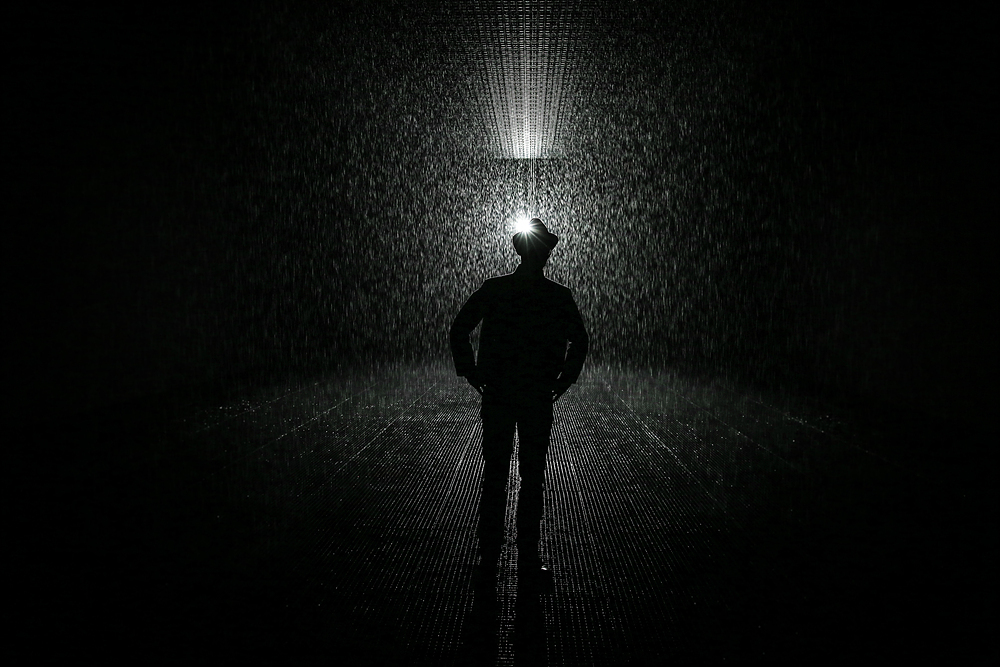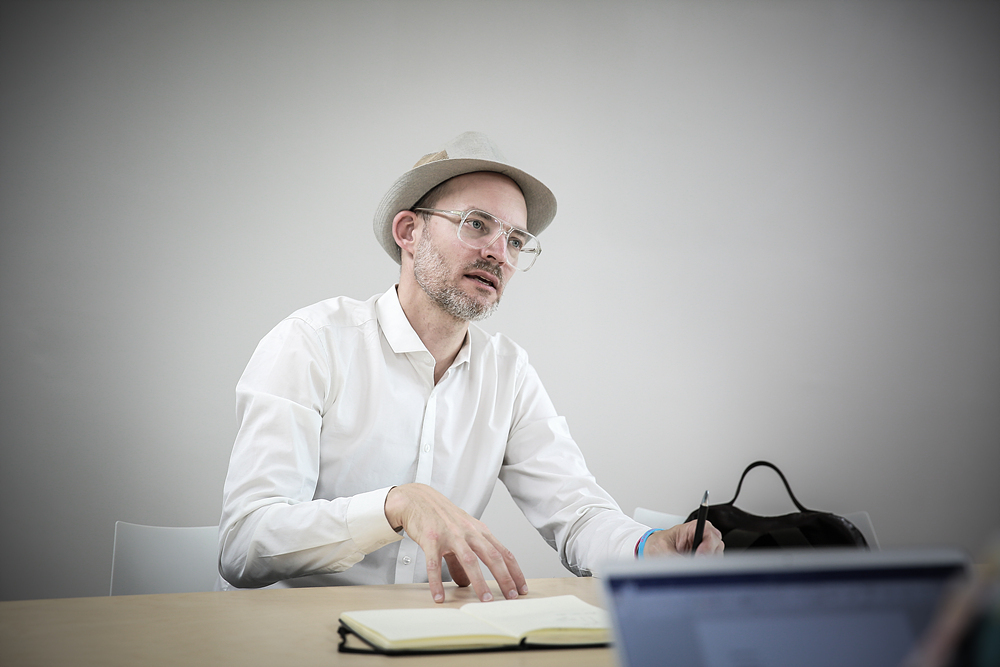In “The Sorcerer’s Apprentice,” Walt Disney’s famous eight-minute animation from 1940 based on a Goethe poem of the same name, Mickey Mouse takes a hold of the magical hat that his master left behind. The apprentice Mickey uses the magical hat to do his chores, but he soon falls asleep, only to wake up to waves of water filling the cavern. Mickey tries to stop the water with his hands, yet fails.
Just when Mickey thought he was in control, disastrous consequences were on the way.
A similar sense of control, and the realization that it was an illusion all along, is something you can experience in “Rain Room” (2012), currently shown at the Museum of Contemporary Art Busan.
 |
Artist Florian Ortkrass of London-based art collective Random International poses for pictures in "Rain Room" shown at the Museum of The Museum of Contemporary Art Busan, Aug. 14. (MOCA Busan) |
“Rain Room” is an indoor black box installation that has blended art with technology, created by designers Hannes Koch and Florian Ortkrass, co-founders of the London-based art collective Random International. It made its debut at London’s Barbican Centre in 2012 and was later shown at New York’s Museum of Modern Art in 2013.
In this black box installation, you walk through a torrent of water yet surprisingly stay dry. You can move around, stretch your arms and look above you but you’re still not wet, giving you the sense that you are in control of the rain.
But that sense of control may not last long. As soon as you are convinced that you’re in control and you decide to just rush into the falling water droplets, you will find yourself soaked. The lesson to be learned is that the sensors from the ceiling detect visitors’ presence, and the rain directly above them is programmed to pause.
After all that you learn that you were never in charge, and it was the sensor that regulated your behavior all along.
This “cool experience” is certainly what stands out about “Rain Room.” You have the glittering raindrops, illuminated by a spotlight in a corner of the black box. You hear the torrent of water constantly falling around you, see the silhouettes of people against the spotlight. Photos cannot come out wrong.
However, the installation will certainly leave you with some afterthoughts. Most of all, it forces us to think about the relationship between ourselves and the systems we have built around us.
 |
Artist Florian speaks during an interview with The Korea Herald on Aug. 14 at the Museum of Contemporary Art Busan. (MOCA Busan) |
“I think what we have to do -- we don’t necessarily push very hard a certain message but -- is to create opportunities to learn how we function,” said Random International co-founder Florian Ortkrass during an interview with The Korea Herald on the opening day of the exhibition.
According to the artist, people consider themselves rational, but that is hardly true in reality.
“We think of ourselves as very rational beings. But I think most of our decisions are emotion-driven,” he said. “We post-rationalize a lot, so you say ‘I bought that car because I need to do this, this and that.’ But in the moment, you bought this car because it was just nice.”
Many of the assumptions we make are defense mechanisms, perhaps.
“It’s a bit like when you come to a party. You have to make very quick decisions, whom you want to talk to, whom you like and whom you don’t like. But most of those assumptions are wrong. When I saw you for the first time, I probably made 100 assumptions. They are wrong. But they help me to be sure that I understand the situation, otherwise you would be constantly freak out.”
The art collective’s goal is to engage visitors in thought exercises that hopefully might lead to better self-understanding.
Knowing exactly how we function is important because we could put ourselves in danger otherwise, according to the artist.
“Now we start to make things like artificial intelligence that can maybe very soon understand how we work better than us. It’s like being on a negotiation table, and the one opposite you knows your redlines, and you don’t know your redlines. This puts you in a very disadvantaged position,” he said.
Knowing is the first step and taking action is the next, Ortkrass said.
“The most difficult thing will not be to change technology. We can do that. I think the most difficult thing will be to change ourselves, to change our assumptions. Learning about ourselves and actually making changes in thinking are really difficult.”
The kinds of technology that people use is not a matter of grave concern, the artist continued.
“I always say that we use the technology as tool. It’s not that we set out to say that we need to make art that has a lot of technology in it.”
In Random International’s working processes, ideas always come first, instead of technology. “Rain Room” is also one of many hundreds of ideas that the group ventured to realize. “We have books full of stupid things,” Ortkrass said while opening up his notebook.
“‘Rain Room’ took four years without knowing if it would work, or even worse, without knowing if there is a reason to do it. I mean the reason was because we wanted to do it, but it might have been a failure,” Ortkrass said.
“I always tell the story when we first set it up in the Barbican. It was the day before the opening. The lighting was right. The installation did what we wanted it to do. It was all kind of working. It was a prototype so it was a bit more shaky than what we have here. We stood there, and we said, ‘We like this, but maybe no one else will.’”
Ortkrass said that the projects of Random International are often high-risk because many high-end technologies are still expensive, and also because there is never any guarantee of getting the results the artists expect.
“A good word will be passion, or an adverse will be obsession,” Ortkrass said when asked what drives them to continue their projects.
Still, more and more artists will use technology as tools sooner or later, Ortkrass predicted.
“We had a pretty tough time in terms of people actually recognizing it as art. It was like photography wasn’t art for a long time.” He added, “I think in 10 years, most people would do things that we do now in one way or the other.”
Ortkrass also shared a bit of what Random International is currently working on.
“At the moment we are actually working on something that creates an object out of non-fixed matters, like particles. You can see the particle, but they are not in solid structure. We have visualized it, and we are trying to make it now.”
“Rain Room” will be shown at MOCA Busan until Jan. 27, together with the artist collective’s video work “Swarm Study.”
By Shim Woo-hyun (
ws@heraldcorp.com)






![[Exclusive] Hyundai Mobis eyes closer ties with BYD](http://res.heraldm.com/phpwas/restmb_idxmake.php?idx=644&simg=/content/image/2024/11/25/20241125050044_0.jpg)
![[Herald Review] 'Gangnam B-Side' combines social realism with masterful suspense, performance](http://res.heraldm.com/phpwas/restmb_idxmake.php?idx=644&simg=/content/image/2024/11/25/20241125050072_0.jpg)

